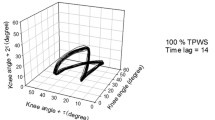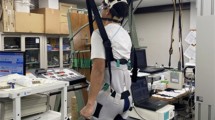Summary
Walking at a constant speed on a steep incline, the ratio of the mechanical work performed, as calculated by the body lift, to the energy expended, as calculated by the oxygen consumption, generally referred to as “efficiency”, is independent of the incline, and it amounts to 0.25 walking uphill and to — 1.2 walking downhill. These values can be regarded as the “efficiency” values for positive (uphill) and negative (downhill) work. Walking on the level or on a mild incline, both positive and negative work are performed within the step cycle. When an equal amount of positive and negative work is performed (level walking or running) the energy level of the body at the end of the performance does not change, and the “efficiency” as calculated amounts to 0.207. This work may be consideredwasted: it reaches a maximal amount on the level of 0.044 kgm/m kg walking, and of 0.088 kgm/m kg running. For this reason a constant pull in the direction of the movement cannot replace completely the pull given by the muscles, as when other systems of progression such as cycling, skiing, skating etc. are adopted. By far the greatest amount of energy spent in walking or running at a constant speed is spent in positive work performance to counteract the deceleration (negative work) taking place at the end of each step. Very little energy is supplied for internal work, i.e. to meet the resistance to progression due to friction within the body or at the contact of the foot with the soil.
Similar content being viewed by others
References
Abbott, B. C., andB. Bigland: The effects of force and speed changes on the rate of O2 consumption during negative work. J. Physiol. (Lond.)120, 319–325 (1953).
Cavagna, G. A., andR. Margaria: Mechanics of walking. J. appl. Physiol.21, 271–278 (1966).
—,F. P. Saibene, andR. Margaria: External work in walking. J. appl. Physiol.18, 1–9 (1963).
— — —: Mechanical work in running. J. appl. Physiol.19, 249–256 (1964).
Hill, A. V.: Trails and Trials in Physiology. London: E. Arnold 1965.
Margaria, R.: Sulla Fisiologia e specialmente sul consumo energetico della marcia e della corsa a varia velocità ed inclinazione del terreno. Atti Reale Acc. Naz. Lincei7, 299–368 (1938).
—,G. A. Cavagna, eF. P. Saibene: Possibilità di sfruttamento dell'elasticità del muscolo contratto durante l'esercizio muscolare. Boll. Soc. ital. Biol. sper.34, 1815–1816 (1963).
—,P. Cerretelli, P. Aghemo, andG. Sassi: Energy cost of running. J. appl. Physiol.18, 367–370 (1963).
Author information
Authors and Affiliations
Additional information
This work has been supported financially by the Italian National Research Council.
Rights and permissions
About this article
Cite this article
Margaria, R. Positive and negative work performances and their efficiencies in human locomotion. Int. Z. Angew. Physiol. Einschl. Arbeitsphysiol. 25, 339–351 (1968). https://doi.org/10.1007/BF00699624
Received:
Issue Date:
DOI: https://doi.org/10.1007/BF00699624




